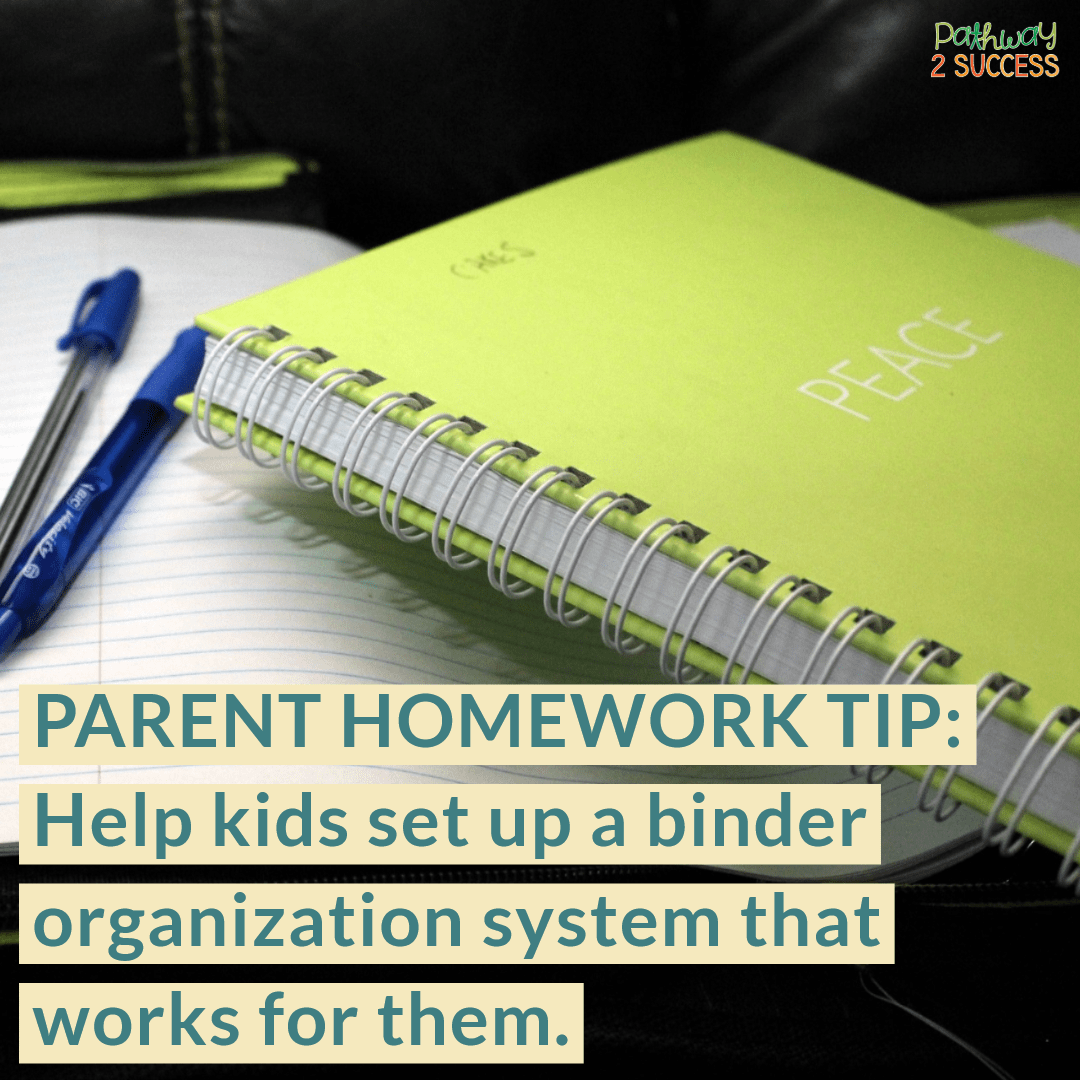
Homework can be a big source of frustration for kids and parents at home. Even more, it can be a challenge that carries over from home to school when the child doesn’t complete the work and is behind in class.
If your child is struggling with homework, read through these strategies and give some a try. As a note, not every single strategy is going to work for every child. To start, pick a few and give them a try. See what works and what doesn’t. Then, move forward together.
If you are an educator looking for strategies for kids, these can help you too. You might even want to pass them along to families to give strategies and support along the way.
Homework Strategies for Home:
Set up a binder organization system. First and foremost, it’s helpful to set your child up with a binder organization system that works for them. This might look different for different learners. One option is having one binder for every class/subject plus a dedicated homework binder. This is ideal for kids who are switching classes and have a good ability to keep track of different binders. In each binder, add a pocket folder and extra paper. In the homework binder, have your child add their homework agenda (read more about that below), a pencil pouch, and a pocket folder just for homework. If this system is too much, consider having one larger binder that contains a homework folder and all classes. You can separate the classes with dividers. While setting up a system most definitely takes time and planning, it helps keep things more orderly in the future.

Use a homework folder. A dedicated homework folder is key to making sure pages get brought home to finish and find their way back to the classroom to be turned in. Using a pocket folder, label one side of the folder “to do” and one side “done.” Explain that assignments that need to be completed, will go on the “to do” side, while pages that are finished will stay in “done.” It’s advisable to purchase a name brand folder to help make sure it lasts a bit longer and stays in the binder. Another tip is to go to the store with your child and let them choose the folder design. There are many different folders with everything from kittens to race cars. Letting the child choose the folder helps them be part of the organization process and might encourage a bit more buy-in. You can use this free homework binder template to get yourself started, or you can make your own!
Teach organization skills on an ongoing basis. Since a big part of completing homework is about organization, it’s important to teach and practice these skills often. Talk about where things should go in the house, take a 5-minute organization break when you need it, and model what organizing materials looks like. If your child struggles significantly with organization, consider reading up more on interventions for organization challenges.

Set up a homework spot. Choose one spot in the house where your child can productively accomplish work on a regular basis. This might be a downstairs office or just the kitchen table. Most importantly, aim to make it consistent and distraction-free.
Have kids use a homework log or agenda. A homework log or agenda is a dedicated place to write homework every day. Often, schools provide homework logs with spots for kids to write work down. If this works, great! Sometimes, though, one isn’t provided or the space might be too small for a child to write in. If that’s the case, you can make your own or use a journal. The key is to set it up so that your child has one spot to write homework down every single day.

Keep the homework area stocked and organized. Keep extra pencils, coloring utensils, and paper ready to go when your child needs it. Having materials organized and stocked will reduce time your child goes looking for it when they need it for an assignment.
Check over the homework log together. Before starting homework, spend a few minutes going over the homework log with your child. Ask them to show you and tell you what assignments they have to do tonight. This is also a great time for positive reinforcement when all homework assignments are clearly outlined, or constructive criticism when they are not. For example, you might say, “I noticed you wrote down ‘study’ under math. What do you think might be more helpful than that for next time?” Then, talk about how you could write down the chapters or topics to study. This homework log check also helps build accountability for your child.

Find alternative ways to check homework. Kids and teens aren’t always perfect about writing their assignments down. Check to see if your child’s teacher has a website where homework is listed. Bookmark the site and have your child use it when they forget to write assignments down. It’s important that it becomes their responsibility to check. If a teacher website isn’t an option, have a homework buddy from class that your child can touch base with. Again, this should be your child’s responsibility when possible. The idea is to teach your child that it is actually easier just to write it down correctly in class the first time!
Be a motivator. It’s no secret that homework isn’t often a favorite activity for kids and teens. Help make it easier by providing encouragement and support in a positive way. You can even start with practicing some positive self-talk and positive affirmations.

Use a timer. A timer can be a valuable tool to help set boundaries and allow breaks. Choose an amount of time that your child should be working, such as 20 minutes. Set the timer and make this a working time. Once the timer goes off, allow a 5 or 10 minute break before heading back to work. A visual timer can be especially helpful in this case because it shows kids and teens just how long they have left until they get their next break. Of course, a simple timer on the oven works, too.
Keep distractions away. We all know that kids and teens love their cell phones. The truth is that these devices are extremely distracting during working times. Make it an expectation that electronics stay away during homework time. Of course, it’s important to mention that this might be incredibly difficult for some kids at first. Work at it to make it a habit for the long-term.

Schedule breaks. It’s healthy to take breaks during long working sessions. Plan to take a break after each course assignment, or after a period of time. Of course, the number of breaks is going to vary greatly depending on your child.
Plan homework times. When it comes to homework, routine is a big part of the puzzle. Plan and schedule daily homework times when possible. Aim for shortly after your child gets home from school if that’s an option. This can allow a short break but still the time to finish the work they need to before dinner and night-time routines. Again, this is going to vary depending on every family situation, since parent work schedules and sports might interfere. If that’s the case, choose any time that works for you. It’s most important to stick with it so that it becomes a routine.
Model focused work. When it’s homework time, model what focused work looks like. While your child is working on assignments, read a book, do crossword puzzles, write in a journal, or complete some work of your own!

Build in choice. Give kids some say when it comes to homework! This will help them feel more empowered and independent. You can let them choose which assignment to start first or how they’d like to start a project. A little bit of choice can go a long way.
Create a homework checklist. Help your child create a daily checklist for homework each day. Encourage them to list out everything they need to accomplish on a piece of paper. Then, prioritize what is most important and start there. Have them check off each assignment on the checklist as they go. This can be done on paper or on a mini whiteboard.
Find a homework buddy. Make sure your child has a friend or classmate they can reach out to when they need homework support. This can be beneficial if they don’t know the assignment or have a question on a specific problem.
Be flexible. If your child wants to do homework a little bit differently than you would recommend, let them try. For example, maybe your child needs to spread out and work on the floor. Perhaps they might really do better while listening to music. These are all recommendations, strategies, and ideas, but remember that there is no one-size-fits-all approach. Be open-minded and find what works for your child.

Recognize when something is taking too long. You know your child best. If he or she spending two hours on a homework assignment, consider taking a look at it together. Provide support and encourage strategies to help them move along. When nothing seems to work, you can also consider adding a note to the back of the page and sending an email to the teacher letting them know the challenges you encountered.
Check homework when finished. Depending on the needs of the child, it may be important to check over and review homework together. Not only it is important to check for completion, but for quality of work. If work isn’t done well, it is worth going back and having your child add or fix what they need to. Eventually, the goal is that they will learn that it’s just easier to do it right the first time!
Plan fun activities after homework. Family game time, watching a favorite show, or heading out for ice cream are all great ways to naturally reward being finished with work.
Develop a home incentive plan. If completing homework is continually a struggle and you suspect motivation is the culprit, consider an incentive or reward plan. Talk with your child about what they would like to earn, such as a movie night with friends or a weekend sleepover. Come up with the terms (such as homework completed every night for a week) and make it happen. The goal with an incentive plan is to develop positive habits and create independence.
Keep in touch with teachers. Remember to stay in contact with your child’s teachers. They are often a source of helpful tips and strategies, but they can’t provide that information if they don’t know your child is struggling. When talking to your child’s teacher about homework challenges, be specific about the difficulties you are seeing an open-minded to trying some strategies. Avoid the blame game. It’s always best when families work with schools on homework issues. If issues continue, do your best to document them and request a face-to-face meeting to discuss further and come up with ideas. Using actual homework samples might also be helpful.

Be a united front with teachers. Even if homework becomes a source of frustration, it’s helpful to remember to act as a united front with your child’s teachers. Certainly, it’s helpful to voice your concerns (and even frustrations) with your child’s teacher privately, but doing it in front of the child can send the wrong message. Again, working together always works best.
Remember to start with just a few strategies, give them a fair shot, and see where they take you. The goal is always that your child can complete the homework independently and feel successful. This may take time, practice, and changing up the strategies along the way, but homework success is possible!







Leave a Reply